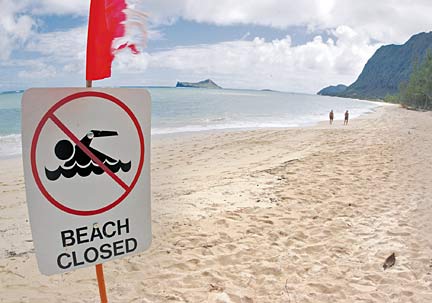
|
Testing
the waters
Hawaii reports 1,169 beach closures
or health advisories in 2004
Sewage spills, heavy winter rains and a stepped-up monitoring system pushed state officials to post 1,169 beach closures or health advisories in 2004, just a year after Hawaii issued none, according to a national environmental group.
|
Top seven states in beach closings and advisories in 2004:
Note: Florida's, Hawaii's and Texas' monitoring is considered limited, while that of other states listed is considered extensive.
Source: Natural Resources Defense Council |
The report says 82 percent of Hawaii's total stems from the state's first-ever "pre-emptive rain advisory," issued from March 2-9, 2004, for all Oahu beaches in an attempt to keep people out of the water during and after heavy showers.
The remaining 214 beach closures or health advisories were due to monitoring that showed elevated bacteria levels from "sewage sources," including storm water or sewage spills, according to the report.
The bulk of the closures or advisories were issued for Oahu beaches. Two were posted on the Big Island.
Kailua Beach had eight closures or advisories for bacteria in 2004, the most of any one swimming area in the state. Meanwhile, Oneawa Beach had seven, and five were recorded for Kalama Beach.
State Health Department spokeswoman Janice Okubo said residents should not be concerned by the numbers.
She attributed much of the huge increase between 2003 and 2004 to a spate of sewage spills and more monitoring mandated under a federal beach protection act.
Last year's council report criticized the state, saying its failure to post any beach closures or health advisories in 2003 was suspect and could point to a faulty monitoring system.
The Health Department, though, defended its system, saying the report did not take into account warning signs posted at beaches after heavy rains.
According to the report, the total number of Hawaii beach closures and advisories issued in 2004 is three times as much as those posted in the previous 13 years combined. The next highest year of closures and advisories was 1991, when 106 were issued.
Carey Morishige, coordinator of Sierra Club Hawaii's Blue Water Campaign, said the statistics should "raise red flags" for residents but not keep them out of the water.
"There is a problem out there," she said. "It just speaks to reiterate and highlight the fact that this land-based pollution is a real problem, and it's not getting better."
Nationwide, the number of closures and health advisories totaled 19,950 in 2004, the most in the 15 years that the council has been monitoring them.
Across the nation, as in Hawaii, the main sources of beach pollution were contaminated storm water and sewage that was not fully treated, said Nancy Stoner, director of the group's Clean Water Project.
The report was released one day after the EPA said in a news release that improved water monitoring and state and local efforts to address pollution have made U.S. beaches "more enjoyable places for Americans to play."
EPA figures show that the percentage of beaches with closings and advisories has stayed relatively steady since 2002.
The findings do not necessarily contradict the NRDC study, which counted the number of closures and warnings, not the number of beaches affected by them.
E-mail to City Desk
[News] [Business] [Features] [Sports] [Editorial] [Do It Electric!]
[Classified Ads] [Search] [Subscribe] [Info] [Letter to Editor]
[Feedback]
